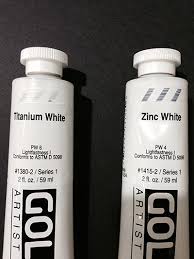
Which White Would You Use to Paint an Eye? - Titanium White vs. Mixing White
Share
It's all about opacity...

Most people use titanium white as their 'go to' white but what are the advantages of using it and why would you then need to use mixing white? After all they are both white, aren't they?
Yes they are the same in colour (hue)... the big difference is in their opacity.
Titanium white is opaque, meaning you can't see through it. If you want to cover up a painted area, get back to the white so you can paint on top with titanium gets great coverage. When tinting i.e. adding white it can form a pastel hue.
Mixing (or Zinc) White is translucent. This means that it is more subtle when mixing colours using it. The brightness of the colour will remain and the paints will not look chalky.
Which White is Right?
The answer to this depends on what you are trying to achieve.
When colour mixing either of these whites will lighten the tonal value but titanium white will have a more pastel, opaque and sometimes chalky effect.
When wanting to cover an area completely use titanium... if you want to glaze or retain translucency consider mixing white.
Using mixing white is useful when you are finding that the titanium white is overpowering the mix. Another example of why you might use mixing white is when painting the eye...
Retaining translucency and painting an eye
Retaining translucency of a transparent colour is not going to happen if you add titanium and this is where mixing white is so great - a wonder when highlighting the eye. Mixing white lightens without creating the pastel tinge as it is translucent, compared to titanium white’s opaque covering abilities. The video below shows Lisa from Lachri Fine Art painting an eye using mixing white, you need to try it for yourself, we tried it in class and it really works.
I hope you enjoyed this blog.
